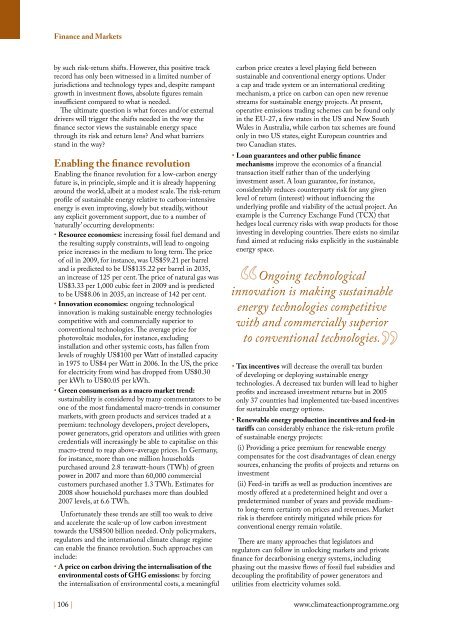Climate Action 2010-2011
You also want an ePaper? Increase the reach of your titles
YUMPU automatically turns print PDFs into web optimized ePapers that Google loves.
Finance and Markets<br />
by such risk-return shifts. However, this positive track<br />
record has only been witnessed in a limited number of<br />
jurisdictions and technology types and, despite rampant<br />
growth in investment flows, absolute figures remain<br />
insufficient compared to what is needed.<br />
The ultimate question is what forces and/or external<br />
drivers will trigger the shifts needed in the way the<br />
finance sector views the sustainable energy space<br />
through its risk and return lens? And what barriers<br />
stand in the way?<br />
Enabling the finance revolution<br />
Enabling the finance revolution for a low-carbon energy<br />
future is, in principle, simple and it is already happening<br />
around the world, albeit at a modest scale. The risk-return<br />
profile of sustainable energy relative to carbon-intensive<br />
energy is even improving, slowly but steadily, without<br />
any explicit government support, due to a number of<br />
‘naturally’ occurring developments:<br />
• Resource economics: increasing fossil fuel demand and<br />
the resulting supply constraints, will lead to ongoing<br />
price increases in the medium to long term. The price<br />
of oil in 2009, for instance, was US$59.21 per barrel<br />
and is predicted to be US$135.22 per barrel in 2035,<br />
an increase of 125 per cent. The price of natural gas was<br />
US$3.33 per 1,000 cubic feet in 2009 and is predicted<br />
to be US$8.06 in 2035, an increase of 142 per cent.<br />
• Innovation economics: ongoing technological<br />
innovation is making sustainable energy technologies<br />
competitive with and commercially superior to<br />
conventional technologies. The average price for<br />
photovoltaic modules, for instance, excluding<br />
installation and other systemic costs, has fallen from<br />
levels of roughly US$100 per Watt of installed capacity<br />
in 1975 to US$4 per Watt in 2006. In the US, the price<br />
for electricity from wind has dropped from US$0.30<br />
per kWh to US$0.05 per kWh.<br />
• Green consumerism as a macro market trend:<br />
sustainability is considered by many commentators to be<br />
one of the most fundamental macro-trends in consumer<br />
markets, with green products and services traded at a<br />
premium: technology developers, project developers,<br />
power generators, grid operators and utilities with green<br />
credentials will increasingly be able to capitalise on this<br />
macro-trend to reap above-average prices. In Germany,<br />
for instance, more than one million households<br />
purchased around 2.8 terawatt-hours (TWh) of green<br />
power in 2007 and more than 60,000 commercial<br />
customers purchased another 1.3 TWh. Estimates for<br />
2008 show household purchases more than doubled<br />
2007 levels, at 6.6 TWh.<br />
Unfortunately these trends are still too weak to drive<br />
and accelerate the scale-up of low carbon investment<br />
towards the US$500 billion needed. Only policymakers,<br />
regulators and the international climate change regime<br />
can enable the finance revolution. Such approaches can<br />
include:<br />
• A price on carbon driving the internalisation of the<br />
environmental costs of GHG emissions: by forcing<br />
the internalisation of environmental costs, a meaningful<br />
carbon price creates a level playing field between<br />
sustainable and conventional energy options. Under<br />
a cap and trade system or an international crediting<br />
mechanism, a price on carbon can open new revenue<br />
streams for sustainable energy projects. At present,<br />
operative emissions trading schemes can be found only<br />
in the EU-27, a few states in the US and New South<br />
Wales in Australia, while carbon tax schemes are found<br />
only in two US states, eight European countries and<br />
two Canadian states.<br />
• Loan guarantees and other public finance<br />
mechanisms improve the economics of a financial<br />
transaction itself rather than of the underlying<br />
investment asset. A loan guarantee, for instance,<br />
considerably reduces counterparty risk for any given<br />
level of return (interest) without influencing the<br />
underlying profile and viability of the actual project. An<br />
example is the Currency Exchange Fund (TCX) that<br />
hedges local currency risks with swap products for those<br />
investing in developing countries. There exists no similar<br />
fund aimed at reducing risks explicitly in the sustainable<br />
energy space.<br />
Ongoing technological<br />
innovation is making sustainable<br />
energy technologies competitive<br />
with and commercially superior<br />
to conventional technologies.<br />
• Tax incentives will decrease the overall tax burden<br />
of developing or deploying sustainable energy<br />
technologies. A decreased tax burden will lead to higher<br />
profits and increased investment returns but in 2005<br />
only 37 countries had implemented tax-based incentives<br />
for sustainable energy options.<br />
• Renewable energy production incentives and feed-in<br />
tariffs can considerably enhance the risk-return profile<br />
of sustainable energy projects:<br />
(i) Providing a price premium for renewable energy<br />
compensates for the cost disadvantages of clean energy<br />
sources, enhancing the profits of projects and returns on<br />
investment<br />
(ii) Feed-in tariffs as well as production incentives are<br />
mostly offered at a predetermined height and over a<br />
predetermined number of years and provide mediumto<br />
long-term certainty on prices and revenues. Market<br />
risk is therefore entirely mitigated while prices for<br />
conventional energy remain volatile.<br />
There are many approaches that legislators and<br />
regulators can follow in unlocking markets and private<br />
finance for decarbonising energy systems, including<br />
phasing out the massive flows of fossil fuel subsidies and<br />
decoupling the profitability of power generators and<br />
utilities from electricity volumes sold.<br />
| 106 |<br />
www.climateactionprogramme.org












